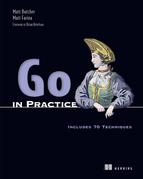List of Figures
Chapter 1. Getting into Go
Figure 1.2. Goroutines running in threads distributed on the available processing cores
Figure 1.3. Passing variables between goroutines via a channel
Figure 1.4. Code coverage displayed in a web browser
Figure 1.5. Java and Go running in an operating system
Figure 1.6. Python, PHP, and Go paths of a client request
Figure 1.7. “Hello, my name is Inigo Montoya” viewed in web browser
Chapter 2. A solid foundation
Figure 2.1. Usage structure of a simple application
Figure 2.2. Usage structure of an application with commands and subcommands
Figure 2.3. The path portion of the URL used in routing requests
Chapter 3. Concurrency in Go
Chapter 4. Handling errors and panics
Chapter 5. Debugging and testing
Figure 5.1. Components of a log file
Chapter 6. HTML and email template patterns
Figure 6.1. Using nested subtemplates to share common template code
Chapter 7. Serving and receiving assets and forms
Figure 7.1. A Go application communicating over HTTP compared to a common web server model
Figure 7.2. A browser fetches a different application and asset set in each environment.
Chapter 8. Working with web services
Figure 8.1. REST API version in the URL
Figure 8.2. Differences between semantic URLs and API version in URL
Chapter 9. Using the cloud
Figure 9.1. The types of cloud computing
Figure 9.2. The layers of cloud services can sit on each other.
Figure 9.3. Comparing containers and virtual machines
Figure 9.4. gox builds binaries for different operating systems and architectures concurrently.
Chapter 10. Communication between cloud services
Figure 10.1. A simple transcoding application broken into microservices
Figure 10.2. Messages being passed with and without connection reuse
Chapter 11. Reflection and code generation
